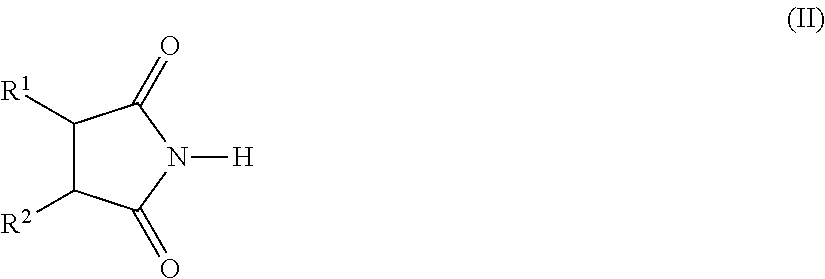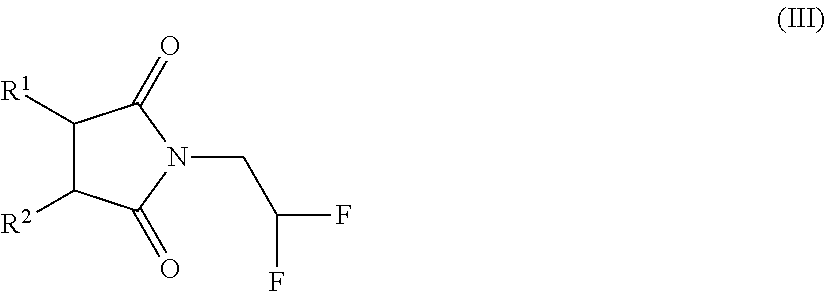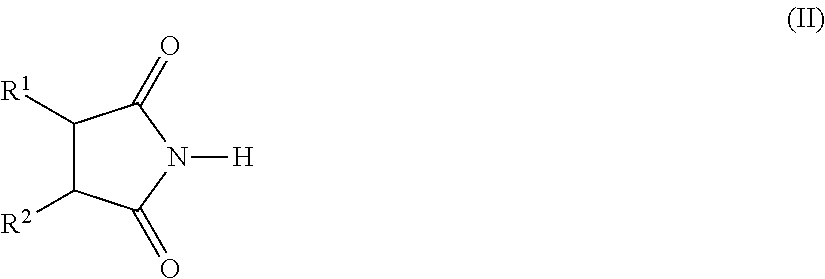Process for the preparation of 2,2-difluoroethylamine
a technology of difluoroethylamine and difluoroethylamine, which is applied in the preparation of amino compounds, organic chemistry, chemistry apparatus and processes, etc., can solve the problems of unsuitable commercial-scale use of known processes, and achieve the effect of simple and inexpensive methods
- Summary
- Abstract
- Description
- Claims
- Application Information
AI Technical Summary
Benefits of technology
Problems solved by technology
Method used
Image
Examples
preparation examples
Example 1
Preparation of 2-(2,2-difluoroethyl)-1H-isoindole-1,3(2H)-dione (step (i))
[0051]
example 1.1
[0052]An amount of 27.6 g (0.269 mol) of 2,2-difluoro-1-chloroethane, 2.16 g (6.73 mmol) of tetra(n-butyl)ammonium bromide and 20 g (0.135 mol) of phthalimide are dissolved in 95 g of N,N-dimethylformamide and treated with 46.96 g (0.336 mol) of potassium carbonate. The reaction mixture is stirred in an autoclave under pressure at 120° C. for 16 h. After the end of the reaction, cooling is carried out to ambient temperature and the solvent is exhaustively removed under vacuum. The remaining residue is treated with 150 ml of water and the solid is filtered off. The filter residue is washed twice with water and the product is dried under vacuum. An amount of 28.5 g of 2-(2,2-difluoroethyl)-1H-isoindole-1,3(2H)-dione with a purity of 97.4% is obtained. This corresponds to a yield of 97.7% of theory.
[0053]1H NMR (CDCl3): 7.91 (d, 2H), 7.7 (d, 2H), 6.06 (tt, 1H), 4.07 (dt, 2H).
example 1.2
[0054]An amount of 27.6 g (0.269 mol) of 2,2-difluoro-1-chlorethane, 2.16 g (6.73 mmol) of tetra(n-butyl)ammonium bromide and 20 g (0.135 mol) of phthalimide are dissolved in 95 g of N,N-dimethylformamide and treated with 28.18 g (0.201 mol) of potassium carbonate. The reaction mixture is stirred in an autoclave under pressure at 120° C. for 16 h. After the end of the reaction, cooling is carried out to ambient temperature and the solvent is exhaustively removed under vacuum. The remaining residue is treated with 100 ml of water and the solid is filtered off. The filter residue is washed twice with water and the product is dried under vacuum. An amount of 24.9 g of 2-(2,2-difluoroethyl)-1H-isoindole-1,3(2H)-dione with a purity of 99.5% is obtained. This corresponds to a yield of 87.2% of theory.
[0055]1H NMR (CDCl3): 7.91 (d, 2H), 7.7 (d, 2H), 6.06 (tt, 1H), 4.07 (dt, 2H).
PUM
| Property | Measurement | Unit |
|---|---|---|
| molar ratio | aaaaa | aaaaa |
| molar ratio | aaaaa | aaaaa |
Abstract
Description
Claims
Application Information
 Login to View More
Login to View More - R&D
- Intellectual Property
- Life Sciences
- Materials
- Tech Scout
- Unparalleled Data Quality
- Higher Quality Content
- 60% Fewer Hallucinations
Browse by: Latest US Patents, China's latest patents, Technical Efficacy Thesaurus, Application Domain, Technology Topic, Popular Technical Reports.
© 2025 PatSnap. All rights reserved.Legal|Privacy policy|Modern Slavery Act Transparency Statement|Sitemap|About US| Contact US: help@patsnap.com



